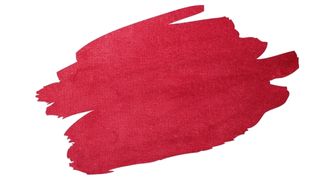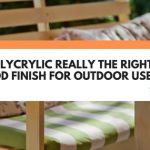Polycrylic is a popular quick-drying wood sealer that does a fantastic job at protecting interior wooden surfaces. What’s more, this urethane-based wood sealer is both scratch-resistant and incredibly easy to apply.
But, is it the best way to protect a coat of chalk paint from scratches?
Well, in this post you’ll learn why you need to seal Chalk paint with a water-resistant sealer. You will also find out exactly how long you should wait before you can seal over freshly applied Chalk paint.
And keep reading to discover why Polycrylic might be the best top coating sealant choice for Chalk paint coated wooden furniture.

This post may contain affiliate links to products that we receive a commission for (at no additional cost to you). Learn more here.
Why Is My Chalk Paint Rubbing Off In The First Place?
Typically, when this happens it’s the result of a lack of a top coating sealant.
You see, Chalk paint is an incredibly easy to apply water-based paint. But, what makes this paint really special is the fact that it doesn’t require surface prep beforehand.
However, its advantageous quick application comes with a slight disadvantage in that it can flake if you don’t seal it.
That is why chalk paint needs a water-resistant (and scratch-proof) top coating seal if you want that color to last.
What Happens If You Don’t Seal Chalk Paint? It will become scratched and distressed. It can also become water-damaged if used on high-usage surfaces.
OK. So What Is The Best Kind Of Sealer You Can Put Over Chalk Paint?
To be honest, most any decent wood sealer will get the job done — provided its a non-penetrating sealant.
Penetrating wood sealers and finishes, (such as Tung oil or Linseed oil), need to sink down into wood to work. However, a dried coat of chalk paint will prevent penetrating sealers/finishes from sinking past that solid coat of color.
So, this leaves you with a choice of non-penetrating wood sealers, such as polyurethane or wood wax.
And How Exactly Do You Make Chalk Paint More Durable (So That It Doesn’t Chip)?
Well, both wood wax and polyurethane can give chalk paint some scratch-resistance.
However, polyurethane is a urethane-based wood sealer that has a fair bit of flexibility to it. That added flexibility allows this sealer to better shrug off scratches than most other sealers.
Also, the urethane in polyurethane makes it more water-resistant than wood wax too. This is a distinct advantage to using polyurethane on a high-usage surface, such as a kitchen table.
And Is Polycrylic The Same Thing As Polyurethane?
Almost, but not quite. They are both urethane-based wood sealers.
However, Polycrylic is an Acrylic/Urethane blended sealer from Minwax. So, the balance of urethane (to other ingredients) in a Polycrylic finish is distinct from that of polyurethane.
On top of that, Polycrylic is a water-based wood sealer, meaning it will dry quickly, and won’t yellow over time.
On the other hand, polyurethane is available as either an oil-based or water-based finish. And sometimes it’s even available as a modified blend of both.
But the key thing to note here, is that Polycrylic will seal and protect in a very similar way to water-based polyurethane.
Related Post: Should You Even Bother Applying Polyurethane Over Polycrylic?
So Can You Use Polycrylic Over Chalk Paint?
You certainly can, as long as you’ve allowed the chalk paint time to wholly dry and cure first.
Also, there is another little thing you need to allow for; adhesion.
If chalk paint leaves behind a very smooth surface, you may experience issues with getting Polycrylic to adhere to it.
You see, Polycrylic will peel off if it’s directly applied onto very smooth surfaces. So, this is why we need to prep wooden surfaces by sanding, before we coat Polycrylic over them.
Light sanding will roughen things up enough to give Polycrylic something to grip onto as this sealant dries. But, the very last thing you want to do is sand and distress a nice coat of paint.
Which is why you may need to use something called a ‘bonding primer’ to help Polycrylic out. A bonding primer is an easy way to get Polycrylic to adhere to a very smooth coat of paint.
Related Post: Can Polycrylic Be Used To Seal And Protect Kitchen Countertops?
And Exactly What Do Bonding Primers Do?
Well, bonding primers are basically binding agents. They act like a sort of glue in between the base coat (chalk paint) and the top coat (Polycrylic).
Now, when it comes to finishing wooden furniture, one of the simplest bonding primers you can use is Dewaxed Shellac.
Dewaxed Shellac is a naturally-sourced (and very sticky) wood finish. It’s a glossy finish too, so it will add shine to the matte appearance of chalk paint.
But, the unique thing about Dewaxed Shellac finishes is that they stick to most anything. And most finishes, (including Polycrylic and chalk paint), will stick to Dewaxed Shellac in return.
On top of that, this wood finish is incredibly easy to apply thinly. But that’s only provided you use a Spray-On Dewaxed Shellac (rather than a brush-on Shellac).
And a thin application of this finish is exactly what you need. Why? Well, because you only need it to act as a binding agent. You aren’t using it as a final top coat.
Related Post: Can You Really Apply Wood Wax Over Shellac? (Best Practice Revealed!)
So, a single thin coat of Spray-on Dewaxed Shellac will create a sticky enough surface for Polycrylic. And once done, you can apply a Spray-on Polycrylic over it.
Now, for best results, there are two key things that are worth emphasizing here:
1). Stick to using Spray-on Finishes/Sealers
If you want to apply thin coats of Shellac or Polycrylic, use the Spray-can versions of either wood finish.
Spray-on application not only saves time, it also reduces the chances of air bubbles appearing in these finishes too.
Related Post: Help! Why Are There Air Bubbles In My Polycrylic Finish! [+ What You Can Do To Fix It]
2). Stick to using Dewaxed Shellac
Not all shellac finishes are equally suited as bonding primers.
Waxed Shellac sits at the opposite end of the stickiness spectrum, compared to Dewaxed Shellac.
You see, whilst anything will stick to Dewaxed Shellac, next to nothing will adhere to a Waxed Shellac finish.
Related Post: Can You Put Shellac Over Paint (Best Practice Revealed!)
And How Long After Applying Chalk Paint Can I Go Ahead And Apply Polycrylic?
You need to wait for chalk paint to both dry and cure first. It can take chalk paint around 24 hours to evaporate and dry, turning from a liquid into a film.
However, curing is a separate process that turns a paint film into a durable solid substance. And in the case of chalk paint, it can take anywhere from 5 to 14 days for this product to cure (depending on humidity).
Now, it’s important you wait for chalk paint to cure, even if you are using a bonding primer over it. That is because coating Polycrylic (or Shellac) over still-curing paint can cause air bubbles to become trapped in these finishes.
Related Post: Why Are There Bubbles In My Shellac Wood Finish? [+ How To Get Rid Of Them]
To Wrap Up, Here Are The 3 Key Takeaways From This Post…
- 1). Chalk paint will flake and peel off if it isn’t top coated with a durable water-resistant sealant.
- 2). You can seal Chalk paint with a non-penetrating water-resistant sealant, such as wood wax or Polycrylic.
- 3). Always wait for Chalk Paint to dry and cure first, before applying Polycrylic over it.


![Help! Why Are There Air Bubbles In My Polycrylic Finish! [+ What You Can Do To Fix It] bubbles in polycrylic finish](https://www.thewoodworkplace.com/wp-content/uploads/2022/10/Banner-490-150x150.jpg)
